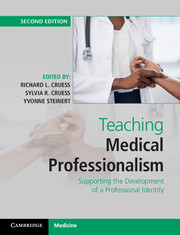Book contents
- Frontmatter
- Contents
- List of contributors
- Foreword
- Introduction
- Part I What is to be taught and learned
- Part II Theory
- Part III Principles
- 8 General principles for establishing programs to support professionalism and professional identity formation at the undergraduate and postgraduate levels
- 9 Faculty development to support professionalism and professional identity formation
- 10 Becoming interprofessional: professional identity formation in the health professions
- 11 Assessment of professionalism and progress in the development of a professional identity
- 12 Remediation of unprofessional behavior
- 13 Professional identity formation, the practicing physician, and continuing professional development
- 14 Professionalism, professional identity, and licensing and accrediting bodies
- Part IV Case studies in promoting professionalism and professional identity formation across the continuum
- Part V The future
- Index
- References
8 - General principles for establishing programs to support professionalism and professional identity formation at the undergraduate and postgraduate levels
from Part III - Principles
Published online by Cambridge University Press: 05 April 2016
- Frontmatter
- Contents
- List of contributors
- Foreword
- Introduction
- Part I What is to be taught and learned
- Part II Theory
- Part III Principles
- 8 General principles for establishing programs to support professionalism and professional identity formation at the undergraduate and postgraduate levels
- 9 Faculty development to support professionalism and professional identity formation
- 10 Becoming interprofessional: professional identity formation in the health professions
- 11 Assessment of professionalism and progress in the development of a professional identity
- 12 Remediation of unprofessional behavior
- 13 Professional identity formation, the practicing physician, and continuing professional development
- 14 Professionalism, professional identity, and licensing and accrediting bodies
- Part IV Case studies in promoting professionalism and professional identity formation across the continuum
- Part V The future
- Index
- References
Summary
When the first edition of this book was written, there was a substantial body of information in the literature on how to design and implement programs to teach professionalism at the undergraduate and postgraduate levels. It was possible to elaborate a set of principles on the subject based on both our experience and that of others.1–3 As we transition to recommending the addition of supporting professional identity formation as the educational objective, equivalent experience is not reflected in the medical literature. Any principles designed to assist individuals in establishing such programs must be derived from the literature on identity formation outside of medicine,4,5 from the thoughts and recommendations of those who have studied professional identity formation in physicians,6–11 and from the recommendations of authors who have contributed to this book.
As is emphasized repeatedly in this book, the experience gained in teaching professionalism has been enormously valuable and provides a foundation upon which educational programs on professional identity formation can be built. While some of the principles elaborated to help design programs of teaching professionalism are still useful, new principles are required for new educational objectives.
Any set of principles must be compatible with the complex nature of the medical curriculum, through which individuals become transformed from members of the lay public into skilled physicians.12 When the teaching of professionalism was the educational objective, there was no unanimity of opinion on how best to organize the teaching, with two schools of thought being predominant. Those who emphasized the need for detailed knowledge of the subject tended to stress formal instruction, making the nature of professionalism explicit.13–15 They defined professionalism, listed its attributes, emphasized the role of trust, and stressed its importance to medicine's relationship to society. Others believed that the teaching of professionalism should be approached primarily as a moral endeavor, emphasizing altruism and service, stressing the importance of role modeling, efforts to promote self-awareness, community service, and other methods of acquiring experiential knowledge.
While it would be wrong to overemphasize the differences between these two approaches, they did exist. Establishing professional identity formation as the educational goal quite effectively brings the two groups together. As medicine is a community of practice that students and residents wish to join (see Chapters 1 and 5), the values and norms of the community must be widely known and communicated to learners.
- Type
- Chapter
- Information
- Teaching Medical ProfessionalismSupporting the Development of a Professional Identity, pp. 113 - 123Publisher: Cambridge University PressPrint publication year: 2016
References
- 3
- Cited by



